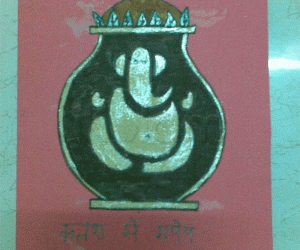Romanesco
About Romanesco : PRINT
Hello little readers,
Have you ever eaten a Romanesco? Don't you think it looks interesting? A Romanesco is a vegetable, and is a cross between brocolli and cauliflower. Some people say that is tastes sweeter than a cauliflower. This vegetable is high in vitamin C, and can be cooked or steamed.





Comments
jkmrao
Fri, 2009-02-13 03:19
Permalink
I have not eaten it. But this is one of the most interesting vegetables.
I can write a book on its looks! This is a "fractal" vegetable, perhaps a
great example. It is also an example for logarithmic spiral. Spirals are
of two kinds - Archimedes spiral, logarithmic spiral. The former grows
uniformly, the latter in a "dynamic" way. You know, the Romanesco,
the waves in the ocean, the spiral galaxies, the flowers, the song and
poem structures in prosody, the tALa system in music, the cones on the
pineapple, and many similar ones are related by a common thread - the
hEmachandra-Fibonacci series. What is known as Fibonacci series
(1,1,2,3,5,8,13,21,34,59, etc. Each number in the series is the sum of
the previous two) in the West was discovered by the great gujarAtI scholar
hEmachandra at least fifty years earlier. In his days, hEmachandra was
known as sarvaj~na, the all-knowing. He was a Jain scholar, wrote may be
more than sixty books. He wrote three literary treatises - the SabdAnuSAsana
(the treatise on word), the kAvyAnuSAsana (the treatise on literary work) and
ChandOnuSAsana (the treatise on prosody). Even today, a prestigious award is made
in his name carrying big money. What has this to do with rangOli? Many of
the patterns we draw (like the tendrils and flowers, etc.) are an offshoot of
this series. While mostly we have static symmetry in our rangOli, this series
is related with growth and so the symmetry here is "dynamic".
That much for the little excitement!
Regards! - mOhana
Lata
Fri, 2009-02-13 19:27
Permalink
mOhanaji, I first came to know about its fractal properties through my college professor a few years back. She touched upon it a bit while discussing the Fibanacci series. She didn't mention anything about Hemachandra (I would say the detail was/is vital from what I gather from you). Everything else like the pinecone, the sunflower, the pineapple and the other examples were known/familiar to all of us. But, the romanesco wasn't in season then, and so we couldn't see it, also, it wasn't easily available anywhere in our neighborhood (or maybe we didn't pay attention). None of us in our class had seen it then. I happen to buy this recently from our local farmer's market for the first time, mainly to take a closer look into it, and of course to show it all of my family members. "What IS that"? was what everybody in our house had asked when they first laid their eyes on it. I couldn't bring myself to cut it for cooking purposes, and so it is still there in our fridge, slowly turning brown on the edges.
Thank you for the big precious description!
I sort off posted this addressing it to our young readers, because I'm sure some or many of our adult members would've/could've seen it, or know about it already
Asha, I saw it only recently, and have never eaten it before. It is too pretty to consume
ashanagendra
Fri, 2009-02-13 04:57
Permalink
Lata it looks like tiny green spruce (pine family),its quiet interesting ,this is the first time i am seeing this vegetable.thankyou for sharing.
jkmrao
Fri, 2009-02-13 20:06
Permalink
Donald Knuth in his Computing methods book has given credit to hEmachandra
for discovering this series. In fact, its relative, the binary numbers, and
binomial theorem were known to pingala and halAyudha for more than 1500 years.
Manjul Bhargava, a professor at Princeton, once discussed about the musical beats
and hEmachandra-Fibonacci series on NPR. All the members may enjoy it if they
haven't already heard it. The link is -
http://www.npr.org/templates/story/story.php?storyId=4111253
(Bhargava on Number Theory)
My interest in this is through prosody (ChandaSSAstra) and music.
Musically rAmA and ramaNA have the same number of syllabic instants (four).
There are five ways of obtaining four syllabic instants (1111, 211, 121, 112, 22).
How one integrates these in poetry and music is also a sort of symmetry in
which I am interested. Wherever there is growth like the growth of a flower,
or the Sankha we were discussing a few days ago, there is this series and
dynamic symmetry.
Regards! - mOhana